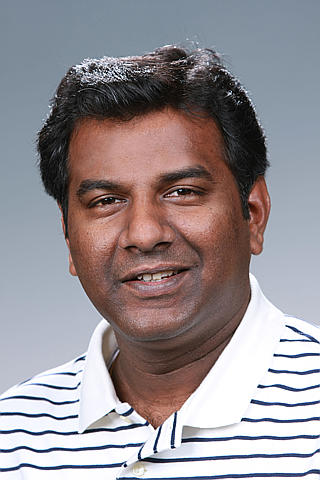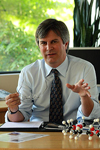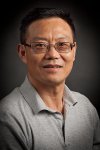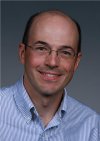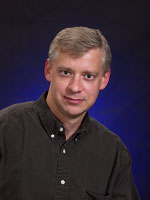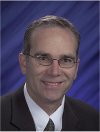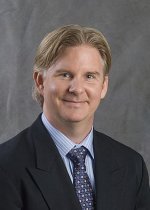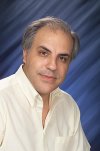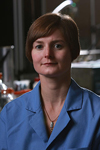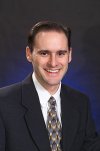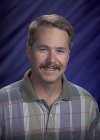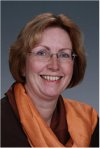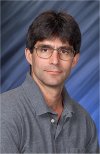2012
Advancing scientific frontiers. If your work is truly influential, you'll be viewed as an expert in the science world and beyond. One measure of impact is when others seek out your insights.
Our Newsmakers page features experts from PNNL's Fundamental & Computational Sciences Directorate who've been recently quoted, asked to speak to influential organizations, or taken on national or international appointments
Smith and Rodland on Proteomics in Science
Pacific Northwest National Laboratory Director of Proteomics Dr. Richard (Dick) D. Smith and Dr. Karin Rodland, Director of Biological Separations and Mass Spectrometry were quoted in a feature on Life Science Technologies in the August 31 issue of Science magazine. "Panning the Proteome for Biomarker Gold." The article features proteomics work being done by nine scientific institutions around the world to find biomarkers for cancer and other diseases.
September 2012
Science's "Editor's Choice" Highlights Research

Dr. Minghuai Wang
Dr. Minghuai Wang, atmospheric scientist at Pacific Northwest National Laboratory, was lead author on a publication featured as an editor's choice highlight in the journal Science on September 7. The article, titled "Constraints from Above," describes the research to develop a new metric from satellite-derived measurements showing how current climate models overestimate aerosol effects on the amount of cloud. The research was performed by an esteemed team of scientists led by Wang including Drs. Steven Ghan, Xiaohong Liu, Kai Zhang, Mikhail Ovchinnikov, Richard Easter, Duli Chand and Yun Qian at PNNL; Dr. Tristan L'Ecuyer of University of Wisconsin; Dr. Hugh Morrison of NCAR; Dr. Roger T. Marchand of University of Washington; and Dr. Joyce E. Penner of University of Michigan. See also, "How to Catch Aerosols in the Act."
September 2012
Phil Rasch Quoted in Seattle Post-Intelligencer on Cloud Brightening

Dr. Phil Rasch
Dr. Philip Rasch, Pacific Northwest National Laboratory, was quoted in an article about new research exploring a way to counteract some features of climate change. The article, published in the Seattle PI online newspaper, details research by a team of scientists, including Rasch, about a concept called marine-cloud brightening, that would increase cloud cover over the ocean to reflect sunlight away from the Earth. Rasch is chief scientist for atmospheric sciences at PNNL and a prominent researcher in the area of geoengineering, which looks at ways to alter the atmosphere to mitigate some effects of global warming. The research was published in the Philosophical Transactions of the Royal Society A in September.
Dilip Ganguly in Nature as Community Choice Selection
Dr. Dilip Ganguly, Pacific Northwest National Laboratory, was mentioned in a Nature community choice article "Aerosols Keep Down Monsoon Rain" on August 1. Ganguly led a research team at PNNL that found local and remote sources of pollution effectively reduce the summer monsoon rainfall over South Asia. Nature's Community Choice articles feature "the most viewed papers in science." The Nature article also notes that Ganguly's publication was in the most highly read for all American Geophysical Union journals for the week of July 23. The publication has ranked in the top tier of "most popular journal articles" in Journal of Geophysical Research since July 23. See "Pollution Weakens Monsoon's Might."
August 2012
Morris Bullock Quoted in National Academy of Science Workshop Report
Dr. Morris Bullock, Director the Center for Molecular Electrocatalysis at Pacific Northwest National Laboratory, was quoted in The Role of the Chemical Sciences in Finding Alternatives to Critical Resources: A Workshop Summary. Bullock spoke at the 2011 workshop on the need to develop catalysts based on earth-abundant metals, creating catalysts that can replace those based on noble metals. Bullock is quoted in the workshop report, which was published by the National Academy of Science through the Chemical Sciences Roundtable.
July 2012
Tony Janetos, Climate Expert on Fox Television
Dr. Anthony C. Janetos, Pacific Northwest National Laboratory, was interviewed by the Fox television Washington, D.C., affiliate on July 6, 2012, as an expert on global climate change. Janetos, who directs the Joint Global Change Research Institute, a partnership between PNNL and the University of Maryland, commented about this summer's heat wave and extreme storm event in the Washington, D.C., area. Janetos said that recent heat waves are on top of a long-term pattern of rising regional temperatures, in effect making them more noticeable. View the video telecast.
July 2012
Tony Janetos, Seattle Science Festival 2012
Dr. Anthony C. Janetos, Pacific Northwest National Laboratory, was a featured speaker at the 2012 Seattle Science Festival in June. Janetos, who directs the Joint Global Change Research Institute, a partnership between PNNL and the University of Maryland, talked about the difficulty of balancing the growing global needs for energy and food with the realities of rapid changes in the atmosphere and climate. Janetos presented how the scientific community uses both observations and models to understand societal changes, understanding the potential consequences of those choices and the urgency of the problems. View video of the presentation (beginning at 1:04:54).
June 2012
Karin Rodland interviewed by ProteoMonitor, KONA Radio
GenomeWeb's ProteoMonitor and KONA Radio ![]() interviewed Pacific Northwest National Laboratory Fellow and cancer biologist Karin Rodland about a collaborative study on triple-negative breast cancer research. PNNL, Walter Reed Medical Center, and Windber Research Institute are teaming on a 20-month, $8.6-million project for the Department of Defense. Learn more, PNNL News Center.
interviewed Pacific Northwest National Laboratory Fellow and cancer biologist Karin Rodland about a collaborative study on triple-negative breast cancer research. PNNL, Walter Reed Medical Center, and Windber Research Institute are teaming on a 20-month, $8.6-million project for the Department of Defense. Learn more, PNNL News Center.
May 2012
Todd Schaef and Casie Davidson featured on NBC Local News
Todd Schaef and Casie Davidson, scientists at Pacific Northwest National Laboratory, were interviewed for an NBC Local News story regarding the use of underground basalt rock for the storage of carbon dioxide gases, aired May 22. The story described how scientists at Pacific Northwest National Laboratory are researching local basalt formations as an option for controlling greenhouse gas emissions. Their research involves injecting liquid CO2 into porous basalt formations which over time will combine to eventually form a solid carbonate mineral that will remained buried forever. This process could go a long way toward mitigating global climate change. May 2012
Chuck Peden and Darrell Herling, C&E News
Pacific Northwest National Laboratory's extensive research on new methods for controlling emissions from fuel efficient "lean-burn" vehicles was featured in Mitch Jacoby's cover story in the May 21 issue of Chemical and Engineering News. The article described considerable recent advances in catalytic converters. Dr. Chuck Peden was quoted on the subject of copper-chabazite catalysts for the selective catalytic reduction of harmful nitrogen oxides. Two captioned images of Peden and Dr. Darrell Herling were included in the article; one photo showing Peden and Herling comparing new and used diesel particulate filters, and the other photo featuring them conducting catalytic emission control tests on a diesel-fueled engine. May 2012
Doug Ray interviewed on "How on Earth"
Dr. Doug Ray, Associate Laboratory Director at Pacific Northwest National Laboratory, was interviewed for the radio program "How on Earth," produced by Jim Pullen of Boulder, CO. "How on Earth ![]() " is a half-hour weekly show that discusses current topics in science. The May 1, 2012, show focused on climate engineering options for addressing carbon dioxide emissions to curb the resulting climate change. Ray stressed that there are many unanswered questions and that there is a critical need for more research into potential solutions to reduce the levels of carbon dioxide in the atmosphere. May 2012
" is a half-hour weekly show that discusses current topics in science. The May 1, 2012, show focused on climate engineering options for addressing carbon dioxide emissions to curb the resulting climate change. Ray stressed that there are many unanswered questions and that there is a critical need for more research into potential solutions to reduce the levels of carbon dioxide in the atmosphere. May 2012
Doug Ray Quoted in a Story About the Future of Energy
Doug Ray, Associate Laboratory Director for the Fundamental & Computational Sciences Directorate at Pacific Northwest National Laboratory, was quoted in an article titled "The Future of Energy: There is No Silver Bullet on April 16, 2012. Ray was quoted during a panel discussion at the University of Colorado Boulder at the 64th annual Conference on World Affairs. He expressed that further encouraging the development of a national carbon policy, such as a carbon cap and trade or a carbon tax system, could be a good way to transition to an energy system that is much cleaner than the one we currently have. April 2012
Monte Helm featured in NewScientist
The work of Pacific Northwest National Laboratory's scientist, Dr. Monte Helm and his team was featured in the cover story of the April 16 issue of NewScientist (subscription required). The article described the challenges of artificial photosynthesis and discussed various options for catalysts. Monte and his team developed a new catalyst that uses nickel and discovered that it worked much faster than the hydrogenase found in nature, which utilizes two atoms of iron to stir up the electrons. While Helm's concept has not been actually used in a photosynthetic system, it shows promise due in part to nickel's abundance and cost-effectiveness. The research was originally featured in Science, vol 333, p 863. April 2012
Julia Laskin in Chemical & Engineering News
Dr. Julia Laskin, Pacific Northwest National Laboratory, was featured in the April 16, 2012, issue of Chemical & Engineering News. The article discusses a new award, now being given annually by the Women Chemists Committee of the American Chemical Society at their annual spring meeting. The "Rising Star Award" honors female chemists at the midpoint of their careers and aims to recognize and retain women in the field of chemistry. Ten women, representing a diverse range of chemistry specialties, were honored at this initial presentation. Laskin was selected for this award in deference to her work in gas-phase ion chemistry and mass spectrometry of complex molecules. April 2012
Tony Janetos Testifies on Climate Variability and Change
Dr. Anthony C. Janetos gave testimony on the impacts of rising sea levels on domestic infrastructures to the U.S. Senate Committee on Energy and Natural Resources in Washington, D.C. on April 19, 2012. Read "Vulnerability of Energy Infrastructure to Sea-Level Rise and Climate Variability and Change or hear a webcast of the testimony by Janetos and the other four panelists. April 2012
Chongmin Wang and Fei Gao in Chemical and Engineering News
The research of Drs. Chongmin Wang and Fei Gao of Pacific Northwest National Laboratory was highlighted and quoted in the March 26, 2012, issue of Chemical and Engineering News. The article, "Watching Battery Anodes In Action" discussed chemical and physical changes Wang, Gao, and their team observed when viewing a silicon-carbon anode in a nano-sized lithium-ion battery while it was being charged and discharged. The eventual aim of this research is to increase the charge capacity of lithium-ion batteries by replacing the carbon anodes with a silicon-carbon nanocomposite. April 2012
Richard Moss in NJSpotlight, Energy & Environment News
Dr. Richard Moss of Pacific Northwest National Laboratory was quoted in an article titled "Weather Report: Wild with a Chance of Record Heat, Precipitation" in the March 29, 2012, edition of NJSpotlight's Energy & Environment News. Moss was quoted during a Rutgers University symposium titled "Extreme Weather and Climate Change: How can we address uncertainty?" He commented that the evidence to link changes in the frequency and intensity of tropical storms to human-caused climate change is not yet solid. Moss is a scientist working at the Joint Global Change Research Institute, a partnership between PNNL and the University of Maryland. April 2012
Tony Janetos, Expert for "Climate Science 101"
Dr. Anthony C. Janetos of Pacific Northwest National Laboratory explains the impacts of climate change in "Climate Science 101," a short course series recently released online. Janetos was instrumental in designing the course, sponsored by Osher Lifelong Learning Institute at George Mason University, and the National Oceanic and Atmospheric Administration (NOAA). In the presentation, Janetos explains the evidence of climate impacts on the U.S. economy, the environment, and our use of natural resources. Janetos is Director of the Joint Global Change Research Institute, a partnership between PNNL and the University of Maryland. The presentation and short-course videos are now available on the NOAA ClimateWatch website. March 2012
John Cort in Chemical & Engineering News
The chemical forensics work of Pacific Northwest National Laboratory Fundamental and national security scientists appear in the February 6 cover story of Chemical & Engineering News, "Tracing a Threat." The article, which includes quotes from Dr. John Cort, Dr. Carlos Fraga, Dr. David Wunschel, and Dr. Helen Kreuzer explores the world of chemical forensic research and the scientific advances being made to link chemical weapons to their source, history, and maker. This work is sponsored by the Science and Technology Directorate of the U.S. Department of Homeland Security. February 2012
Jun Liu in Chemical and Engineering News
Dr. Jun Liu, Pacific Northwest National Laboratory, was quoted in an article titled "Nanoparticle Catalysts that Rest on Graphene" in the February 3 issue of Chemical & Engineering News, a weekly magazine published by the American Chemical Society. This publication covers science and technology, business and industry, as well as government and policy aspects of the chemistry field. In this article, Liu commented on work done a Brown University. He spoke to the problems associated with polymer-electrolyte-membrane fuel cells and some of the challenges moving forward. February 2012
Tony Janetos, Weather and Climate Summit

Tony Janetos participated in a climate change panel discussion at the 2012 Glen Gerberg Weather and Climate Summit.
Dr. Anthony C. Janetos, Pacific Northwest National Laboratory, was a featured speaker at the 2012 Glen Gerberg Weather and Climate Summit in January. The event gathered television weathercasters, meteorologists and leading climate researchers in the U.S. and Canada for education and information exchange. Janetos, Director of the Joint Global Climate Research Institute, was a featured speaker at the summit and also part of a climate change panel discussion with Ms. Eileen Shea of the U.S. National Oceanic and Atmospheric Administration and Dr. John Furlow of the United States Agency for International Development. View presentations and panel discussions on the StormCenter YouTube channel.
January 2012
Chuck Long and John Shilling in Atmospheric Measurement Laboratory News Video
Drs. Chuck Long and John Shilling of Pacific Northwest National Laboratory explained about the complex mixing of chemicals in the atmosphere through a KNDU/KNDO-TV news report that aired on January 24. The report also featured the Atmospheric Measurement Lab's Environmental Chamber where scientists study formation of tiny chemical particles under conditions similar to those found in the atmosphere. This "atmosphere in a box" is a one-of-a-kind testing instrument at PNNL, and is helping researchers advance the science on aerosols, tiny bits of smoke, soot, and chemicals in the air that affect climate change. View the minute-plus video here.
January 2012
2011
Tony Janetos, Nature
Dr. Anthony C. Janetos, Pacific Northwest National Laboratory, was quoted in an opinion article published in Nature about the necessity to promote the value of science during challenging budget times. Janetos, who directs the Joint Global Change Research Institute, a partnership between PNNL and the University of Maryland, commented on the difficulties faced by research scientists who pursue participation in public policy discussions.
December 2011
Jie Xiao, Talking Points Memo
Dr. Jie Xiao, Pacific Northwest National Laboratory, is quoted in "How graphene is helping to build a better electric car battery," which appears in Talking Points Memo, an online news organization that provides breaking news for the politically engaged. Xiao talks about her team's latest research into lithium-air batteries. By using a new form of graphene, the PNNL and Princeton University team achieved the highest energy storage capacity to date: 15,000 milliamp hours per gram.
December 2011
Tristram West, Nature Climate Change
Dr. Tristram O. West, Pacific Northwest National Laboratory, wrote an analysis published in the November 2011 issue of Nature Climate Change titled "Mitigation: Monitoring Informs Management." West, a research scientist at the Joint Global Change Research Institute, a partnership between PNNL and the University of Maryland, analyzed methods to monitor greenhouse gas emissions from crops.
December 2011
Jerome Fast Receives AGU Editors' Citation
Dr. Jerome Fast, Pacific Northwest National Laboratory, received an American Geophysical Union 2010 journals editors' citation for excellence in refereeing. The editors' citation recognizes a special contribution to AGU. Fast, an atmospheric scientist, was commended for consistently providing constructive and thoughtful reviews for the journal JGR-Atmospheres. November 2011
Dan DuBois, Science
Dr. Dan DuBois, Pacific Northwest National Laboratory, is quoted in Robert F Service's article, "Turning over a New Leaf" in the November 18, 2011 issue of Science Magazine. The article discussed different approaches to artificial photosynthesis and the difficulties in splitting water as effectively as plants do in natural photosynthesis. The article describes the challenge of turning electricity from the sun into fuel in an efficient and cost-competitive manner. November 2011
Chuck Peden and Johnathan Holladay in Chemistry & Industry Magazine
Dr. Chuck Peden and Dr. Johnathan Holladay, Pacific Northwest National Laboratory, were quoted in an article titled "Catalysing biomass conversion" in Chemistry & Industry Magazine, published by the Society of Chemical Industry. Holladay talks about the catalysts needed and provides comparisons to the fossil fuel industry. Peden discusses the use of advanced imaging technologies and computational modeling tools to help speed the science behind developing highly effective catalysts for turning biomass into fuels. November 2011
Jun Liu, Chemical and Engineering News
In the November 21, 2011 issue of Chemical and Engineering News, Pacific Northwest National Laboratory's Dr. Jun Liu's and Dr. Jiguang Zhang's team were discussed and quoted by Mitch Jacoby in the story, "Graphene Moves toward Applications." The article referenced PNNL's work in the energy storage arena, specifically discussing a procedure to convert graphene sheets into a new material, which is pictured on the cover of the issue. The new material was used to create new electrode materials for lithium-ion batteries and lithium-air battery with exceptionally high specific storage capacity. November 2011
Jim Dooley, Elizabeth Malone, International Journal of Greenhouse Gas Control
Jim Dooley, Dr. Elizabeth Malone, and Dr. Judith Bradbury (retired) of Pacific Northwest National Laboratory have responded to a rebuttal article concerning their research, to be published in the 2012 Volume 6, Issue 1 of the International Journal of Greenhouse Gas Control. Their original article, "Moving from misinformation derived from public attitude surveys on carbon dioxide capture and storage towards realistic stakeholder involvement," published in the same journal in 2010, was a sharp critique of public surveys both as a tool to gauge public opinion and as a method to inform public policy for carbon capture and storage technologies. Although complimentary of the researchers' rebuttal study, Dooley and Malone maintain that surveys producing pseudo opinions add no value to the literature or to stakeholder involvement efforts. They maintain that dialog about the complex issues involved in CCS is a better strategy for stakeholder involvement and more likely to increase acceptance of new technologies.
Dr. Sotiris Xantheas Work Highlighted in Chemistry World
The work of Dr. Sotiris Xantheas, Pacific Northwest National Laboratory, and team members from Heriot-Watt University, was highlighted in the September 23, 2011, issue of the Royal Society of Chemistry's Chemistry World. The article discussed the team's groundbreaking study of the NH4 (ammonium hydroxide) radical to determine its proper place on the electronegativity scale compared to alkali metals. Electron attraction and repulsion determine how atoms and pseudo-atoms, such as the NH4 radical, behave in different environments. This study provides scientists with the information they need to better predict, manipulate and control those behaviors, whether in batteries for solar farms or catalysts for bio-fuel production September 2011
Rahul Zaveri Featured in Experts Video
Dr. Rahul Zaveri of Pacific Northwest National Laboratory is featured in a new video on PNNL's YouTube channel. Zaveri, a chemical engineer and research scientist, is one of the PNNL's topic experts in a segment titled "The Evolution of Pollution." In the video, Zaveri explains the effects of air pollution on climate change and the unsolved mysteries of increased atmospheric particles produced from the interaction between urban pollution and naturally-occurring hydrocarbon compounds.
Kevin Rosso and Carolyn Pearce, USA Today
Dr. Carolyn Pearce and Dr. Kevin Rosso, Pacific Northwest National Lab, appeared in photos that accompanied an article in USA Today, November 2011. The article is titled "Economy, lack of engineers could hinder U.S. innovation." In the article, Pearce and Rosso's work analyzing mineral samples from a nuclear reprocessing area is mentioned in the caption.
Morris Bullock in Chemical and Engineering News
R. Morris Bullock of Pacific Northwest National Laboratory discussed research carried out at PNNL in an article in C&E News on reducing the nation's reliance on precious metals and rare earths. Precious metals such as platinum are used as catalysts in fuel cells and other applications, and are vital to the nation's energy infrastructure. High costs and low abundance of precious metals, coupled with geo-political concerns over available supplies, have led to research on abundant, inexpensive metals that can be used instead of precious metals. Alternatives to these and more efficient use of these rare elements were the topics of a two-day National Academy of Sciences workshop. Bullock, Director of the Center for Molecular Electrocatalysis, gave an invited talk at the workshop.
Daniel DuBois Quoted in Science and Wired
In October, Daniel DuBois was quoted in Science and Wired about two advances in turning sunlight's energy into chemical fuels. DuBois cautions that issues still remain to be solved, including speed and efficiency. He also notes that the research provides good examples for others striving to end the nation's reliance on fossil fuels.
Jay Grate and Matt O'Hara Quoted in Chemical & Engineering News
The great diversity of elements and complex sample matrix in nuclear waste presents tough challenges to those developing process monitoring methods for waste pretreatment before vitrification, according to Dr. Jay Grate in Chemical & Engineering News. Grate, a materials and analytical chemist at Pacific Northwest National Laboratory, and his colleagues are solving issues around technetium in stored nuclear waste and in groundwater. Technetium is a radioactive element that has high mobility in the environment and a long half-life. The team developed a device designed to quickly pull technetium from nuclear waste process streams, separate it, and rapidly quantify it, providing near-real time analysis results. The article also discusses work by PNNL's Matthew O'Hara and his colleagues. His team is building sensors for autonomous monitoring of radionuclide levels in Hanford Site groundwater plumes. The technology could also aid in groundwater cleanup by monitoring technetium removal in a pump and treat process.
Ram Devanathan in ASCR Discovery
In ASCR Discovery, Pacific Northwest National Laboratory's Ram Devanathan discusses the need for integrating experimental and computational research to resolve the scientific challenges of energy systems, including battery research. The feature story draws on Devanathan's expertise in materials science and conducting computational simulations at different length and time scales.
Morris Bullock Discusses Catalysis Research with BBC, C&E News
In August, Morris Bullock was interviewed by two prestigious news sources regarding a super-fast catalyst that makes hydrogen. The research, conducted by the Center for Molecular Electrocatalysis and directed by Bullock, was recently published in Science and has been garnering media interest. Bullock was interviewed on the BBC's Naked Scientist show. In addition, this research was featured in Chemical & Engineering News, Chemistry World, Green Car Congress, and other publications.
Justin Teeguarden in Forbes, Wall Street Journal
In articles in Forbes and the August 8 Wall Street Journal opinion page, Pacific Northwest National Laboratory toxicologist Dr. Justin Teeguarden was quoted and referenced about the toxicity of bisphenol-A (BPA), an organic compound used in plastics and resins. Teeguarden led a recently published toxicological study BPA that appeared in Toxicological Sciences. The American Council on Science and Health, SmartBrief, and the Plastics News covered the Forbes story.
Chuck Peden quoted in C&E News
In the August 1 issue of Chemical & Engineering News, Pacific Northwest National Laboratory's Chuck Peden is quoted in "Single Atoms Mediate Research." The article by Mitch Jacoby discusses a new wet-chemistry method that can be used to prepare catalysts with isolated platinum atoms on a metal oxide. Peden, Associate Director of the Institute for Integrated Catalysis, is quoted as an outside expert.
Chuck Peden Quoted in Innovations
In the current issue of Innovations magazine, Dr. Chuck Peden of Pacific Northwest National Laboratory's Institute for Integrated Catalysis is quoted extensively in an article titled "Catalysts—Humans and Otherwise." The article discusses catalysis capabilities and expertise at the Department of Energy's EMSL, a national scientific user facility.
Wendy Shaw Featured in DOE Blog
Dr. Wendy Shaw, at Pacific Northwest National Laboratory, was featured on the Department of Energy's Energy Blog. In the article, titled "10 Questions for Biophysical Chemist," Shaw discusses her catalysis and bio-mineralization research, the value of good communication skills, and why Ayla, in Jean Auel's prehistoric novels, is her favorite fictional scientist. Shaw works in the Center for Molecular Electrocatalysis, a DOE Energy Frontier Research Center.
Kerstin Kleese van Dam featured in HPC Source Article
PNNL's Kerstin Kleese van Dam was featured in the HPC Source article "Taming Big Data with Remote 3-D Viz." The article highlights PNNL's scientific data management work supporting the Laboratory's Chemical Imaging Initiative. Kleese van Dam manages the Scientific Data Management group in the Computational Sciences & Mathematics Division.
Greg Schenter Featured in DOE Blog
Dr. Greg Schenter, a chemical theorist at Pacific Northwest National Laboratory, was featured on the Department of Energy's Energy Blog. In the article, titled "10 Questions for a Chemical Theorist," Schenter discusses how he came to his profession, his inspirations, his work, and why Doctor Who is his favorite fictional scientist. Schenter works in the Chemical and Materials Sciences Division at PNNL.
Greg Kimmel quoted in Science
Dr. Greg Kimmel, a Pacific Northwest National Laboratory physicist with extensive expertise in water's behavior, is quoted in the April 8 issue of Science. The quote appears in "Ice is predicted to be weirder still," a news focus on theoretical work into the formation of quasicrystalline ice, which lacks the repeatable patterns seen in ordinary crystals. Kimmel's opinions were sought on how to experimentally produce quasicrystalline ice.
Kerstin Kleese van Dam featured in DOE Pulse
A profile of PNNL's Kerstin Kleese van Dam was featured in the March 21 issue of DOE Pulse. In the article "PNNL's Kleese van Dam makes sense of the data landscape" she discusses PNNL's scientific data management research and the Laboratory's new Chemical Imaging Initiative. Kleese van Dam manages the Scientific Data Management group in the Computational Sciences & Mathematics Division.
Bruce Garrett quoted in Chemical & Engineering News
In "Turning the Corner," an article about the job market for chemists in the western United States, Dr. Bruce Garrett, Director of Pacific Northwest National Laboratory's Chemical & Materials Sciences Division, is quoted several times. Garrett discusses the need for chemists to take on the challenges to move the nation away from fossil fuels. The article appears in the March 21, 2011, issue of Chemical & Engineering News.
Karin Rodland featured in BioTechniques
Pacific Northwest National Laboratory Fellow Dr. Karin Rodland was featured in an article in the February 4 issue of BioTechniques. "Winning a grant in 12 pages or less" gives advice to researchers advice on applying for National Institutes of Health grants. Rodland is PNNL's Department of Health and Human Services Sector Manager.
Bruce Garrett's research highlighted in Chemical & Engineering News
Research by a team of scientists including Dr. Bruce Garrett, a Royal Society of Chemistry Fellow and theoretical chemist, was highlighted in the January 31, 2011, issue of Chemical & Engineering News. The one-paragraph concentrate discusses a study, published in Science, that uses muons to create light and heavy hydrogen mimics, elucidating the kinetic isotope effect.



